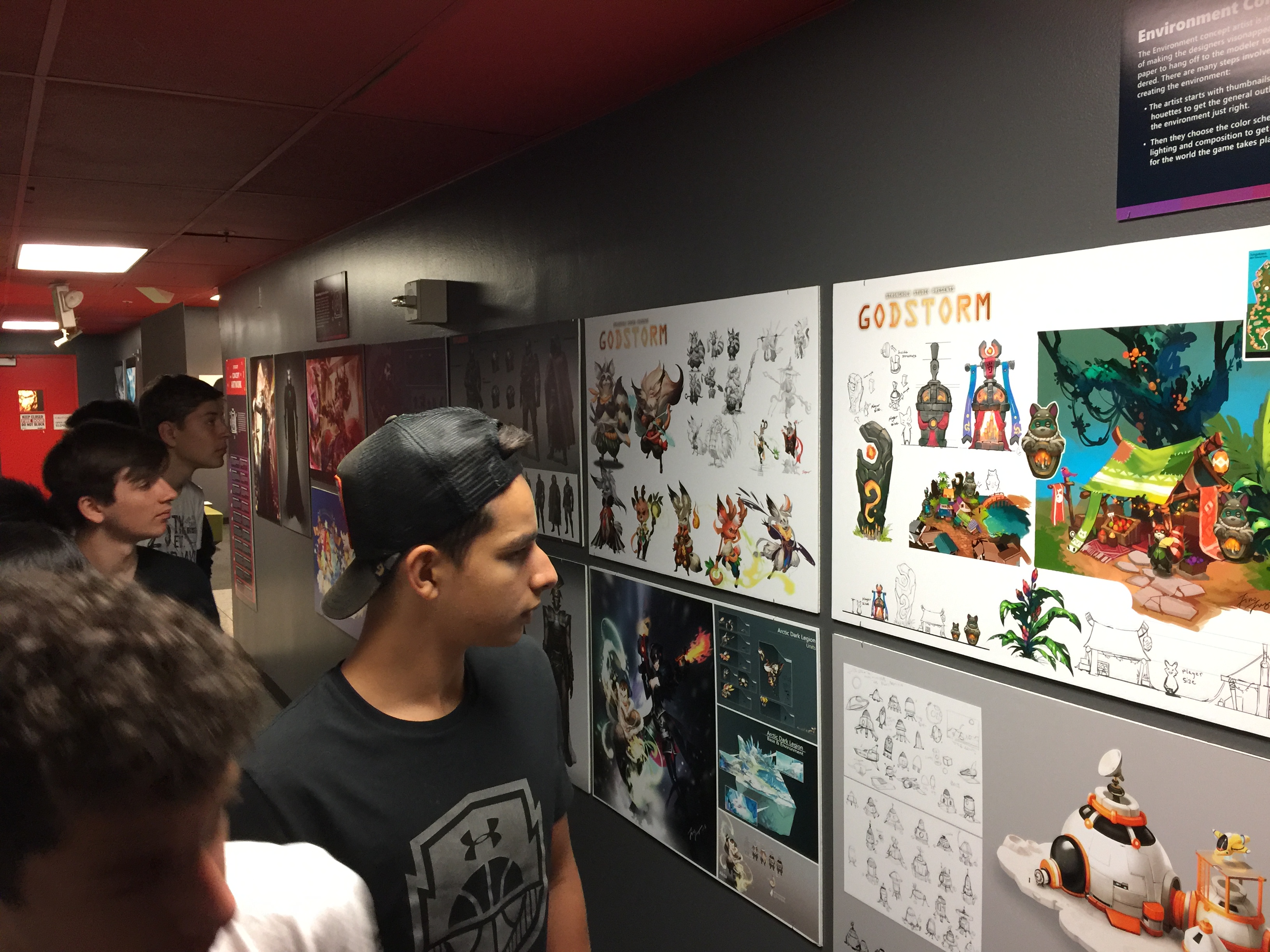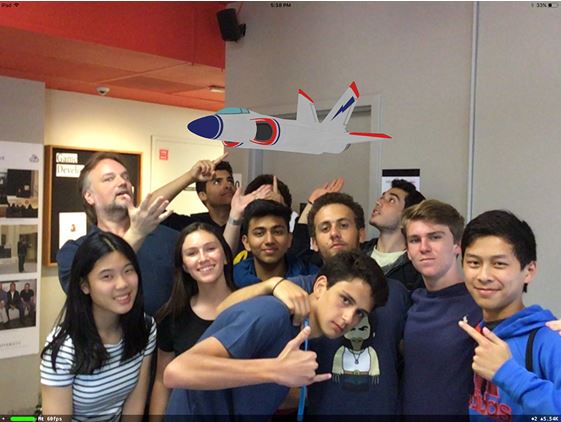
Following KLab America’s closure, I looked for other opportunities. I came across a summer position teaching Computer Game Design within an organization called Summerfuel. It’s a program that invites high-school-age students from around the world to various prestigious university campuses to experience college life for a summer. This particular session is held at UC Berkeley.
The experience was different from anything I was used to, but it was fulfilling. I’ve now returned to teach the class three years running, and I’ll continue to do so.
I was not particularly confident my first time, given that I had never taught a class before. In producing a curriculum, I researched what others had done to introduce newcomers to game design, and came to the conclusion that interactivity was the most important thing to chase.
I decided to make the class as engaging as possible by using my contacts in the industry–and especially in the San Francisco area–to invite luminary guest speakers and line up fantastic field trips. And half of each two-hour lecture was a lab that required creating or playing, and frequently both.
Let’s Play
The very first day every year, I take the class out onto the lawn with my magic bag of crazy props and tell everyone to work together to make up a game (with a little help). The process gives me a lot of insight into the personalities of the students and gets them interacting with each other immediately. The students invariably wander down all sorts of bad paths (someone always finds a way to lose a die or two), but iterate their way to something creative, surprising, and fun. I always end up referring back to this first day multiple times during the rest of the course as an excellent example of iterating to a viable design.
Other games make their way into labs, such as Dixit and Liars’ Dice. Dixit works great with my international kids because it contains no language, just pictures. The clues a player creates require very game design-like skills.

Liar’s Dice is an example of a broken design with a positive feedback loop. Once the players have experience with the game, I have each group change one rule to fix the loop, predict the results, and test it. Did it fix the problem? Is the game more or less fun with the fix?

Paper Prototypes

Before I took the class, the previous lecturer had each student code their own game. I fully acknowledge that students can get valuable experience actually making a working game, but that’s not what I wanted to focus on. Instead, I like to talk about design vision: what are the factors that make a game design solid, and how can you communicate your key concepts to anyone who needs to understand them (people who fund it, people who build it, and people who support it). I’d rather have discussions and activities rather than debug sessions, especially for the less technically inclined.
In this vein, I prefer activities that focus on pure design. One of these asks the students to break down a computer game that they’re already familiar with, identify its core aesthetic, and create a paper prototype to prove it out.

Paper prototypes are valuable tools in game development. I’ve done them a number of time (notably for a mini-game in Rat Race that we had so much fun with that it was hard to put it away). The key is not trying to recreate the game, but recreate the fun or feeling that the game inspires by focusing on a core mechanic.
Here’s a video of one group’s paper prototype of Guitar Hero. A few things to note. First, the song is “Eye of the Tiger” in the background. Second, white notes are supposed to be slapped into the right cup, and black notes into the left. Red notes (dice) are bombs and players lose points if they get one in any cup.
Magic Bus Ride
Unfortunately, Summerfuel didn’t have a bus available, but Berkeley does have a BART station! Every year, I take the group on three different field trips that are located fairly close to the BART. I try to fit in one real game developer, one accredited game school, and one place that’s mostly for fun (I do this trip at the end, kind of as a reward).
Here are a few of the places we’ve visited:

Kixeye. I’ve known Kixeye for years, starting with their hit Facebook game Backyard Monsters. They’ve leveraged that social-game app approach and found success in a number of different titles. I appreciated them taking the time to give the kids a glimpse into the inner workings of their hard-core, numbers-driven studio.

Glu. After Kixeye, the game developer Glu stepped up to become a mainstay. They have been nice enough to let my group visit for two years so far. We’ve seen both of their facilities, and the latest one is amazing. They have historically developed a wide portfolio of products, including Kim Kardashian Hollywood, Diner Dash, and Design Home. Tom Hall and Kevin Sommers have given talks both years so far.

Art Academy University. Steven Goodale (Goody) heads up the design department at the game development arm of this prestigious art school in the heart of San Francisco. The kids were blown away by the examples of work by past students, and the facilities where official school teams compete at the highest level in games like Fortnite. Steven always shows me what his personal summer class is up to, which is usually doing something awesome with the latest technology like AR.
Here are some of the many great pictures from our visits.

Pacific Pinball Museum. This was the first reward visit, and I thought it would be perfect. It’s exactly what it sounds like: a building full of very, very old pinball games up to only recently old ones. Once you’re inside, you can play any of them to your heart’s content. I had a blast, but many of the kids didn’t even know what pinball was. Kids today, huh?
What’s interesting is, because some of the students on the original trip weren’t enthralled, I changed it up for the next year. But then one of the new students said she heard about the Pinball trip and was looking forward to it. I can’t win!

The MADE (Museum of Art and Digital Entertainment). This place has every game ever made. Well, not every game, but you wouldn’t know it when you visit. There are so many of the early game systems kept working by a tireless staff, supported by a huge library of titles. They hold camps there for kids, but also invite visitors to explore and play. And that’s exactly what we did on the second of my reward trips–and we’re intending to return again this year.
Again, a few more pictures.
Be My Guest
I’ve worked in this industry long enough to get to know some talented and generous people, who were kind enough to visit my class to give the kids some exposure to some other mindsets. Like the field trips, I think a mix of experiences works out well and my guests cover a variety of disciplines within game development–important because designers typically have to interact with everyone on the team. Here are some of the people who have visited thus far.

David “Rez” Graham (programmer/designer). I originally worked with Rez at Superego on Rat Race, but he went on to contribute to some incredible products. He worked at Planet Moon, Slipgate, and Playfirst, but really came into his own as lead AI engineer at EA working on games like the SIMS and SIMS medieval. Rez is fixture at the AI roundtables at GDC, but better, he has also come to speak at my class every year to present his unique perspective on the industry.

Chris Hockabout (designer/artist). Chris and I met at Lolapps, working on Ravenshire Castle together, and there he impressed me with his eye for detail and passion for creating a compelling experience for the player. He has since taken the design reins of some major games at Telltale (Game of Thrones and Batman). He’s currently at 2K Games, where I can’t wait to see what he comes up with.

Josh Law (artist/animator). Josh and I met at Lolapps. We were working on different projects, but I was impressed with the quality of his work–especially because he was a recent graduate of AAU. I was lucky enough to recruit him into KLab, where he was instrumental in producing assets and animations for Crystal Casters and Glee Forever. He has since worked at Babeltime on his favorite genre game (tower defense) and then joined Facebook as a technical artist.

John Nevarez (artist/animator). One of the fastest sketch artists I’ve ever seen, John hails from companies like Pixar, Sony Pictures, Illumination Entertainment, and Warner Bros, contributing to movies like Cars and Angry Birds. He has so much experience and advice to offer, it’s impossible to fit it all into the two hour period I have. But most importantly, John fills a critical role in my class: he allows students to describe their vision of a character or place or thing and then draws it for them. There’s nothing like seeing what’s in your head brought to life via a really talented artist and being able to communicate that vision is an important job of a game designer.
What follows is a video of one of those sessions, pulling ideas from these burgeoning designers.
What’s the Pitch?
I haven’t gone into a lot of detail about what my lectures cover, but they introduce the basics of game design: definitions, dynamics, aesthetics, core loops, meta-games, monetization, narrative tools, and a lot more. The students’ final project is to create a pitch of their dream game idea to present to the rest of the class with a slideshow. While many of the pitches fall into established niches (which doesn’t have to be a bad thing; I also discuss risk management and how much innovation is necessary to win your audience over), some have truly surprised me–but I always look forward to seeing how they all come together in the end.
Here are a few of the projects from that class (I’m just showing the title card and one other sample page). These projects were interesting both to look at and listen to, especially when the student was passionate about the idea. Note that while two concepts are original, one relies on a license. I tell my students not to shy away from a property they want to use. Why not? It’s their dream game and nailing the down the license can be a job for another day.

















